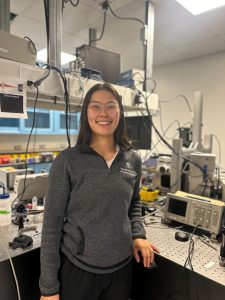
Metasurfaces are 2D diffractive optics that can significantly reduce the size of bulky imaging systems and provide complexity where conventional optics may be limited. My research focuses on the design and fabrication of dielectric metasurfaces for infrared (IR) imaging, a spectral range that has gained popularity for its ability to image in adverse or smoky environments and recover information not visible to standard cameras. In the Valentine group, we develop metasurfaces that exploit this spectral range and provide greater functionalities to existing systems such as depth sensing and edge detection amongst others.
Specifically, my work focuses on developing a metasurface design for velocity measurements to be used with event-based imaging systems, which capture data only during motion. Current vision systems often rely on post-processing with complex algorithms and deep learning models, which can demand significant resources and time, thereby limiting real-time data capture. Our group strives to develop front-end optics, like metasurfaces, to help reduce this back-end computation cost. Though in its initial stages, I aim to incorporate my design to either filter out noise, such as with an edge filter, or to perform computations on the input signal to assist with back-end processing.
In addition to design, I also spend significant time pushing the bounds of our fabrication, as these metasurfaces can present considerable challenges. We primarily use silicon, which is transparent in the IR and widely available throughout industry. However, to minimize loss and achieve the desired metasurface functionalities, we require high aspect ratio features that are challenging to fabricate, often necessitating a careful balance between our design goals and fabrication capabilities. To create our features, we utilize an RIE etch process. We faced two major issues: poor gas diffusion, which caused tapering and filling of our nanoholes, and hard mask erosion due to the prolonged etching process. To address this, I developed a Bosch style recipe using fluorine chemistry with an added de-passivation step to improve the anisotropy and thus sidewalls of our etch. For the latter problem, exacerbated by a change in hard-mask material, we replaced the passivation gas with O₂, significantly enhancing mask selectivity. These solutions enabled us to achieve over a 20:1 aspect ratio for our features, allowing us greater flexibility at the design table and broadening the scope of future projects, particularly in the mid-wave IR.
 My VINSE Story:
My VINSE Story:
It is because of VINSE that I ultimately chose to attend Vanderbilt University, which was the best decision I could have made. The cleanroom is by far my favorite place to be at Vanderbilt, which some might consider rather strange given the frustrating nature of fabrication. Despite its challenges, I find immense joy in showing up every day to conduct cutting-edge research in such a cool facility. I am a frequent denizen of the cleanroom often seen before the Oxford RIE, which played a key role in our recipe development. Additionally, I spent many an hour exclaiming in front of the dual SEM-FIB imaging our samples (which is my second favorite place… sometimes).
I also volunteer as a Nanoguide as part of VINSE’s outreach program, where I teach students the various techniques and technologies we utilize. Even before venturing into my career, I aimed to make outreach a significant part of it to give other students the opportunities I wish I had experienced growing up. I’m thrilled to be able to share the excitement and enjoyment I experience in the cleanroom with others. Being a Nanoguide has given me a true appreciation for what I do and has shown me what a wonderful community we have at VINSE. All the staff are incredibly knowledgeable, and I am excited to continue learning and growing with their guidance.